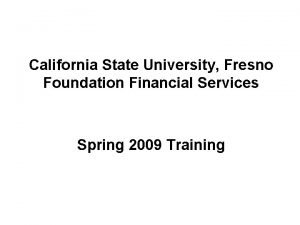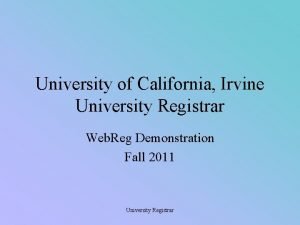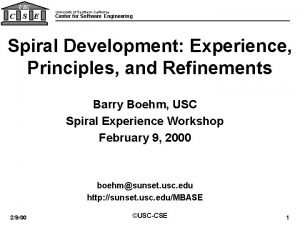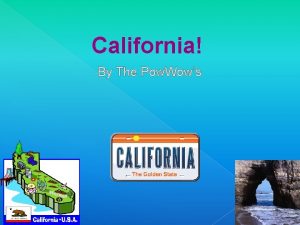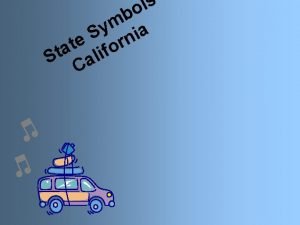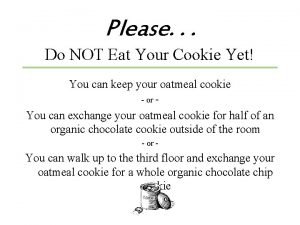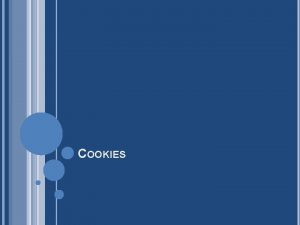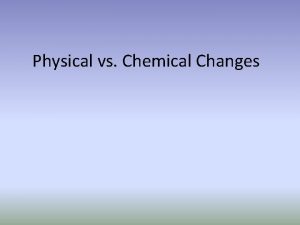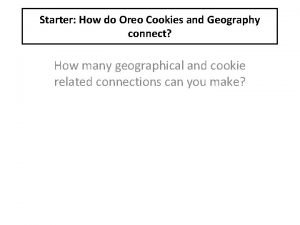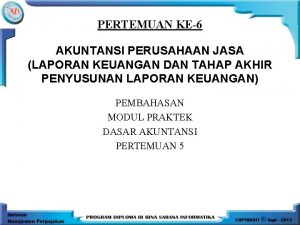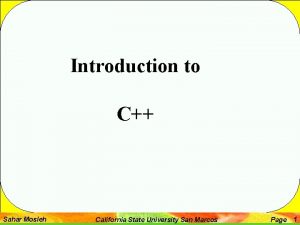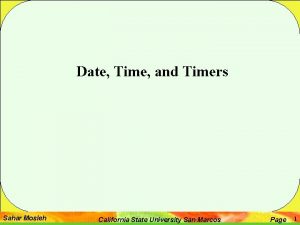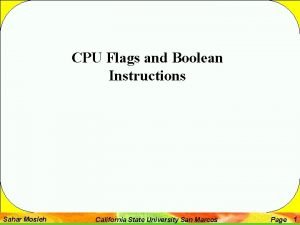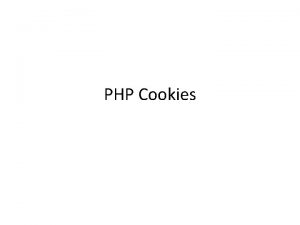Storing Information Cookies Sahar Mosleh California State University



























































- Slides: 59

Storing Information: Cookies Sahar Mosleh California State University San Marcos Page 1

• Our goal as website programmers should be to make the website experience as easy and pleasant for the user as possible. Clearly, well-designed pages with easily navigable layout are central to this, but they’re not the whole story. We can go one step further by learning about our users and using information gained about them to personalize the website. • For example, imagine a user, whose name we asked on the first visit, returns to our website. We could welcome the user back to the website by greeting him or her by name. Another good example is given by a website, such as Amazon’s, which incorporates the oneclick purchasing system. By already knowing the user’s purchasing details, such as credit card number and delivery address, we can allow the user to go from viewing a book to buying it in just one click, making the likelihood of the user purchasing it that much greater. Also, based on information, such as the previous purchases and browsing patterns of the user, it’s possible to make book suggestions to the user. Sahar Mosleh California State University San Marcos Page 2

• Such personalization on websites requires that information about users be stored somewhere in between their visits to the website. We’ve previously talked about the fact that accessing the user’s local file system from a web application is pretty much off limits due to security restrictions included in browsers. However, we, as website developers, can store small amounts of information in a special place on the user’s local disc, using what is called a cookie. There may be a logical reason why they are named cookies, but it also provides authors with the opportunity to make a lot of secondrate, food-related jokes! Sahar Mosleh California State University San Marcos Page 3

Baking Our First Cookie • The key to cookies is the document object’s cookie property. Using this property we can create and retrieve cookie data from within our Java. Script code. • We can set a cookie by setting document cookie to a cookie string. We’ll be looking in detail at how this cookie string is made up later in the chapter, but let’s first create a simple example of a cookie and see where the information is stored on the user’s computer. Sahar Mosleh California State University San Marcos Page 4

A Fresh Baked Cookie • The following code will set a cookie with the user. Name set as Paul, and an expiration date of 28 December 2010. • Save this as Fresh. Bakedcookie. htm. Sahar Mosleh California State University San Marcos Page 5

Viewing Cookies on IE • Before we view the cookies, we’ll first clear the temporary internet file folder for the browser because this will make it easier to view the cookies that our browser has stored. In IF, select internet Options from the Tools menu, as shown in bellow. Sahar Mosleh California State University San Marcos Page 6

Sahar Mosleh California State University San Marcos Page 7

• Click the Delete Files button under Temporary Internet files. We’ll be asked to confirm our request in another dialog box, shown in bellow. Sahar Mosleh California State University San Marcos Page 8

• Check the Delete all offline content check box and then click OK. We’ll be returned to the internet Options dialog box. • Let’s have a look at the cookies we have currently residing on our machines. From the internet Options dialog box, click the Settings button next to the Delete button grouped under Temporary Internet files. We should see the dialog box shown in bellow. Sahar Mosleh California State University San Marcos Page 9

• Now click the View Files button, and a list of all the temporary pages and cookie files on your computer will be displayed. if you followed the instructions previously and deleted all temporary internet files, all you should see are the cookie files on your computer, as these are not deleted. The number of cookie files on your computer will vary Sahar Mosleh California State University San Marcos Page 10

• The actual cookies, their names, and their values, will look slightly different depending on your computer’s operating system. • We can delete each cookie simply by clicking it once, then pressing the Delete key, as you would with any file in Explorer. if we want to delete all cookies, IE 6 has a button on the general tab of the internet Options dialog box to delete cookies. • We can examine the contents of the cookies by double-clicking them Sahar Mosleh California State University San Marcos Page 11

• As we can see, a cookie is just a plain old text file. Each website, or domain name, has its own text file where all the cookies for that website are stored. in this case there’s just one cookie currently stored for google. CO. uk. • Domains like amazon. Com will almost certainly have many cookies set. we can see the cookie’s details. Here, the name of the cookie is PREF; the domain google. CO. uk, and it relates to the root directory /. The contents probably look like a mess of characters. Sahar Mosleh California State University San Marcos Page 12

• Now let’s load the Freah. Baked. Cookie. htm page into our IE browser This will set a cookie. Let’s see how it has changed things by returning to the internet Options dialog box (by choosing the internet Options from the Tools menu). Click the Settings button, and then click View Files. My computer now shows the information shown in bellow. Sahar Mosleh California State University San Marcos Page 13

• Because we are creating a cookie from a web page that is stored on the local hard drive rather than a server, its domain name has been set to code, the directory my page was stored in. Obviously, this is a little artificial. in reality people will be loading our web pages from our website on the internet and not off our local hard drive. The internet address is based on the directory the Fresh. Bakedcookie. htm file was in. We can also see that it expires on December 28, 2010, as we specified when we created the cookie. Double-click the cookie to view its contents. • We can see the name we gave to the cookie at the left, user. Name, its value, Paul, and also the directory it’s applicable to. The expiration date is there as well; it’s just not in an easily recognizable form. Note that we may sometimes need to close the browser and reopen it before we see the cookie file. Sahar Mosleh California State University San Marcos Page 14

Sahar Mosleh California State University San Marcos Page 15

The Cookie String • When creating a cookie there are six parts we can set: name, value, expires, path, domain, and security, although the latter four of these are optional. We’ll now look at each of these in turn. Sahar Mosleh California State University San Marcos Page 16

name and value • The first part of the cookie string consists of the name and value for the cookie. The name is used so that we can reference the cookie at a later date, and the value is the information part of the cookie. • This name/value part of the cookie string is compulsory; it sort of defeats the point of the cookie if you don’t store a name or value because storing information is what cookies are all about. You should make sure that this part comes first in the cookie string. • The value for the cookie is a primitive string, although of course the string can hold number characters if it is numerical data that we want to store. if we are storing text, certain characters, such as semicolons, cannot be used inside the value, unless we use a special encoding, which we’ll see later. in the case of semicolons, this is because they are used to separate the different parts of the cookie within the cookie string. Sahar Mosleh California State University San Marcos Page 17

• In the following line of code, we set a cookie with the name user. Name and the value Paul. • This cookie has a very limited lifespan. By lifespan, we mean the length of time the information will continue to exist. if we don’t set an expiration date, a cookie will expire when the user closes the browser. The next time the user opens the browser the cookie will be gone. This is fine if we just want to store information for the life of a user session, which is a single visit by the user to our website. However, if we want to ensure that our cookie is available for longer, we must set its expiration date, which we’ll look at next. Sahar Mosleh California State University San Marcos Page 18

expires • If we want a cookie to exist for longer than just a single user session, we need to set an expiration date using the second part of the cookie string, expires, as follows: • The cookie set by the previous line of code will remain available for future use right up until December 28, 2010. Note that the format of the expiration date is very important, especially for IE browsers. it should be the same format it is given by the to. GMTstring () method. This method is similar to the to. UTCstring () method that we saw in Chapter 9. Sahar Mosleh California State University San Marcos Page 19

• In practice, we’ll probably use the Date object to get the current date, and then set a cookie to expire three or six months after this date. Otherwise, we’re going to need to rewrite our pages on December 28, 2010. For example, we could write the following: • This will create a new cookie called User. Name with the value of Paul and it will expire 6 months from the current date. Note that other factors can cause a cookie to expire before its expiration date, such as the user deleting the cookie or the upper cookie limit being reached. Sahar Mosleh California State University San Marcos Page 20

path • We’ll find that 99 percent of the time, we will only need to set the name, value and expires parts of a cookie. However, at times the other three parts, such as the path part that we are looking at here, need to be set. The final two parts, domain and secure, are for more advanced use beyond the scope of a beginners’ book, but we’ll look at them briefly just for completeness. • We know that cookies are specific to a certain path, but what if we want to view our cookies from two different paths on our server? Say for example we have an online store at www. mywebsite. com/ mystore/ but we subdivide the store into subdirectories, such as /Books and /Games. Now let’s imagine that our checkout is in the directory www. mywebsite. com/mystore/Checkout. Any cookies set in the /Books and /Games directories won’t be visible to each other or pages in the /Checknut directory. To get around this we can either set cookies only in the /mystore directory, since these can be read by that directory and any of its subdirectories, or we can use the path part of the cookie string to specify that the path of the cookie is /mystore even if it’s being set in the /Games or /Books or /Checkout subdirectories. Sahar Mosleh California State University San Marcos Page 21

• For example, we could do this like so: • Now, the cookie will be available to all directories on the domain it is set from. if the website is just one of many at that domain, it’s best not to do this because everyone else will also have access to our cookie information. • It’s important to note that while Windows computers don’t have case-sensitive directory names, many other operating systems do. For example, if our website is on a Unix- or Linux-based server, the path property will be case sensitive. Sahar Mosleh California State University San Marcos Page 22

domain • The fourth part of the cookie string is the domain. An example of a domain is wrox. com or pawilton. com. Like the path part of the cookie string, the domain part is optional and it’s unlikely that you’ll find yourself using it very often. • By default, cookies are available only to pages in the domain they were set in. For example, if we have our first website running on a server with the domain My. Personalweb. Site. My. Domain. com and we have a second website running under My. Businesswebsite. My. Domain. com, a cookie set in one website will not be available to pages accessed using the other domain name, and vice versa. • Most of the time this is exactly what we want, but if it is not, we can use the domain part of the cookie string to specify that a cookie is available to all subdomains of the specified domain. Sahar Mosleh California State University San Marcos Page 23

• For example, the following sets a cookie that can be shared across both subdomains: document. cookie =“User. Name=Paul; expires=Tue, 28 Dec 2010 00: 00; path-/” + ; domain-Myflomain. com; ”; • Note that the domain must be the same: We can’t share www. Someone. Elses. Domain. com with www. My. Domain. com. Sahar Mosleh California State University San Marcos Page 24

secure • The final part of the cookie string is the secure part. This is simply a Boolean value; if it’s set to true the cookie will only be sent to a web sever that tries to retrieve it using a secure channel. The default value, which is false, means the cookie will always be sent, regardless of the security. This is only applicable where we have set up a server with SSL (Secure Sockets Layer). Sahar Mosleh California State University San Marcos Page 25

Creating a Cookie • To make life easier for ourselves, we’ll write a function that allows us to create a new cookie and set certain of its attributes with more ease. We’ll look at the code first and create an example using it shortly. Sahar Mosleh California State University San Marcos Page 26

• The secure and domain parts of the cookie string are unlikely to be needed, so we just allow the name, value, expires, and path parts of a cookie to be set by the function. if we don’t want to set a path or expiration date, we just pass empty strings for those parameters. if no path is specified, the current directory and its subdirectories will be the path. if no expiration date is set, we just assume a date six months from now. • The first line of the function introduces the escape () function, which we’ve not seen before. Sahar Mosleh California State University San Marcos Page 27

• When we talked about setting the value of a cookie, we mentioned that certain characters cannot be used directly, such as a semicolon. (This also applies to the name of the cookie. ) To get around this problem, we can use the built-in escape() and unescape() functions. The escape () function converts characters that are not text or numbers into the hexadecimal equivalent of their character in the Latin-1 character set, preceded by a % character. Sahar Mosleh California State University San Marcos Page 28

• For example, a space has the hexadecimal value of 20, and the semicolon has the value of 3 B. So, the following code produces the output shown in Figure 1143. • alert(escape(” 2001 a space odyssey; ’)); • We can see that the spaces have been converted to %2 0, % indicating that they represent an escape or special character rather than an actual character, and that 20 is the ASCII value of the actual character The semicolon has been converted to %3 B, as we’d expect. Sahar Mosleh California State University San Marcos Page 29

• As we’ll see later, when retrieving cookie values we can use the unescape () function to convert from the encoded version to plain text. • Back to our function; we next have an if statement. Sahar Mosleh California State University San Marcos Page 30

• This deals with the situation where an empty string, “, has been passed for the cookie. Expires parameter of the function. Because most of the time we want a cookie to last longer than the session it’s created in, we set a default value for expires that is six months after the current date. • Next, if a value other than an empty string (“ “) has been passed to the function for the cookiepath parameter, we need to add that value when we create the cookie. We simply put path=” in front of any value that has been passed in the cookiepath parameter • Finally on the last line we actually create the cookie, putting together the cookie. Name, cookie. Value, cookie. Expires, and cookie Path parts of the string. Sahar Mosleh California State University San Marcos Page 31

• We’ll be using the setcookie () function whenever we want to create a new cookie because it makes setting a cookie slightly easier than having to remember all the parts we want to set. More importantly, it can be used to set the expiration date to a date six months ahead of the current date. • We’ll now put this together in a simple example in which we use our setcookie () function to set three cookies named Name, Age, and First. Visit. We then display what is in the document. cookie property to see how this has been affected. Sahar Mosleh California State University San Marcos Page 32

Sahar Mosleh California State University San Marcos Page 33

• Save the example as createcookie. htm, and then load it into a web browser • Note that all three cookies are displayed as name/value pairs separated by semicolons, and also that the expiration date is not displayed. if we had set the path parameter, this also would not have been displayed. The User. Name cookie from a previous example is also displayed. Sahar Mosleh California State University San Marcos Page 34

Getting a Cookie’s Value • In the preceding example, we used document. cookie to retrieve a string containing information about the cookies that have been set. However, this string has two limitations. • First, the cookies are retrieved in name/value pairs, with each individual cookie separated by a semicolon. The expires, path, domain, and secure parts of the cookie are not available to us and cannot be retrieved. • Second, the cookie property allows you to retrieve only all the cookies set for a particular path and, when hosted on a web server, that web server So, for example, there’s no simple way of just getting the value of a cookie with the name Age. To do this we’ll have to use the string manipulation techniques we’ve learned in previous chapters to cut the information we want out of the returned string. • A lot of different ways exist to get the value of an individual cookie, but the way we’ll use has the advantage of working with all cookieenabled browsers. We use the following function: Sahar Mosleh California State University San Marcos Page 35

Sahar Mosleh California State University San Marcos Page 36

Getting a Cookie’s Value • In the preceding example, we used document. cookie to retrieve a string containing information about the cookies that have been set. However, this string has two limitations. • First, the cookies are retrieved in name/value pairs, with each individual cookie separated by a semicolon. The expires, path, domain, and secure parts of the cookie are not available to us and cannot be retrieved. • Second, the cookie property allows you to retrieve only all the cookies set for a particular path and, when hosted on a web server, that web server So, for example, there’s no simple way of just getting the value of a cookie with the name Age. To do this we’ll have to use the string manipulation techniques we’ve learned in previous chapters to cut the information we want out of the returned string. Sahar Mosleh California State University San Marcos Page 37

• A lot of different ways exist to get the value of an individual cookie, but the way we’ll use has the advantage of working with all cookieenabled browsers. We use the following function: Sahar Mosleh California State University San Marcos Page 38

• The first task of the function is to get the document cookie string and store it in the variable cookie. Value. • Next we need to find out where the cookie with the name passed as a parameter to the function is within the cookievalue string. We use the indexof 0 method of the String object to find this information, as shown in the following line. • The method will either return the character position where the individual cookie is found or -l if no such name, and therefore no such cookie, exists. We search on + cookie. Name + “=“ so that we don’t inadvertently find cookie names or values containing the name that we require. For example, if we have x. Foo, and y. Foo as cookie names, a search for Foo without a space in front would match the x. Foo first, which is not what we want! Sahar Mosleh California State University San Marcos Page 39

• If cookie. Starts. At is -1, the cookie does not exist or it’s at the very beginning of the cookie string so there is no space in front of the cookie name. To see which of these is true, we do another search, this time with no space. • in the next if statement we check to see whether the cookie has been found. if it hasn’t, we set the cookie. Value variable to null. Sahar Mosleh California State University San Marcos Page 40

• If the cookie has been found, we get the value of the cookie we want from the document. cookie string in an else statement. We do this by finding the start and the end of the value part of that cookie. The start will be immediately after the equals sign following the name. So in the following line, we find the equals sign following the name of the cookie in the string by starting the indexof () search for an equals sign from the character at which the cookie name/value pair starts. • We then add one to this value to move past the equals sign. The end of the cookie value will either be at the next semicolon or at the end of the string, whichever comes first. We do a search for a semicolon, starting from the cookiestarts. At index in the next line. Sahar Mosleh California State University San Marcos Page 41

• If the cookie we are after is the last one in the string, there will be no semicolon and the cookie. Ends. At variable will be -1 for no match. in this case we know the end of the cookie value must be the end of the string, so we set the variable cookie. Ends. At to the length of the string. • We then get the cookie’s value using the substring () method to cut the value that we want out of the main string. Because we have encoded the string with the escape () function, we need to unescape it to get the real value, hence the use of the unescape () function. Sahar Mosleh California State University San Marcos Page 42

• Finally we return the value of the cookie to the calling function. • Now we know how to create and retrieve cookies. Let’s use this knowledge in an example where we check to see if any changes have been made to a website since the user last visited it. • We’ll be creating two pages for this example. The first is the main page for a website; the second is the page with details of new additions and changes to the website. A link to the second page will only appear on the first page if the user has visited the page before (that is, a cookie exists) but has not visited since the page was last updated. Sahar Mosleh California State University San Marcos Page 43

Sahar Mosleh California State University San Marcos Page 44

Sahar Mosleh California State University San Marcos Page 45

Sahar Mosleh California State University San Marcos Page 46

• This page needs to be saved as Main. Page. htm. Note that it contains the two functions, set. Cookie () and getcookievalue ( ), that we created earlier. Also note that the image whats. New. gif is referenced by this page; either create such an image, or retrieve the image from the code download. • Next, we’ll just create a simple page to link to for the What’s New details. • Save this page as Whats. New. htm. Sahar Mosleh California State University San Marcos Page 47

• Load Main. Page. htm into a browser. The first time we go to the main page, there will be just a heading saying “Welcome to my website”. Obviously if this were a real website, it would have a bit more than that, but it suffices for our example. However, refresh the page and suddenly we’ll see the page shown bellow. • If we click on the image, we’re taken to the whats. New. htm page detailing all the things added to the website since we last visited. Sahar Mosleh California State University San Marcos Page 48

How It Works • The whats. New. htm page is just a simple html page with no script, so we will confine our attention to Main. Page. htm. in the head of the page in the first script block, we declare the variable lastupdated. • Whenever we make a change to the website this variable needs to be changed. it’s currently set to Tue, 28 Dec 2010 just to make sure we see a “What’s New” image when we refresh the page. A better alternative for live pages would be the document. last. Modified property, which returns the date the page was last changed. • The rest of the first script block contains the two functions getcookievalue () and setcookie () that we looked at earlier These haven’t changed, so we won’t discuss them in detail here. Sahar Mosleh California State University San Marcos Page 49

• The interesting material is in the second script block that is found within the body of the page. First we get the date of the user’s last visit stored in the Last. Visit cookie using the getcookievalue () function. • if it’s null, the user has never been here before, or it has been six or more months since the last visit, and the cookie has expired. Either way, we won’t put a “What’s New” image up because everything is new if the user is a first time visitor, or a lot has probably changed in the last six months—more than what our What’s New page will detail. • if lastvisit is not null, we need to check whether the user visited the site before the site was last updated, and if so direct the user to a page that shows what is new. We do this within the if statement. Sahar Mosleh California State University San Marcos Page 50

• We first create a new Date object based on the value of last. Visit and store that back into the lastvisit variable. Then, in the condition of the inner if statement, we compare the date of the user’s last visit with the date we last updated the website. if things have changed since the user’s last visit, we write the What’s New image to the page, so the user can click it and find out what’s new. Note that we have used the escape character “ for the inside the strings that are written to the page because, otherwise, Java. Script will think they indicate the end of the string. Sahar Mosleh California State University San Marcos Page 51

• Finally, at the end of the script block, we reset the Last. Visit cookie to today’s date and time using the setcookie () function. Sahar Mosleh California State University San Marcos Page 52

Cookie Limitations • You should be aware of a number of limitations when using cookies. • The first is that while all modern browsers support cookies, the user may have disabled them. in NN we can do this from the Preferences option on the Edit menu. The option to disable cookies is under Advanced on NN 4. x, and under the Cookies option under Advanced on NN 6. In IE it’s under internet Options on the Tools menu. Select the Security tab and click the Custom Level button. From there, a list of security options appears, some of which relate to the setting of cookies. • Both the functions that we’ve created for creating and getting cookies will cause no errors when cookies are disabled, but of course the value of any cookie set will be null and we need to make sure our code can cope with this. Sahar Mosleh California State University San Marcos Page 53

• We could set a default action for when cookies are disabled. For example, in the previous example, if cookies are disabled, a What’s New image will never appear. • Alternatively, we can let the user know that our website needs cookies to function by putting a message in the web page warning users. • Another way is to actively check to see whether cookies are enabled and, if not, take some action to cope with this, such as directing the user to a page with less functionality that does not need cookies. How do we check to see if cookies are enabled? • In the following script we set a test cookie, and then read back its value, if it’s null, we know cookies are disabled. Sahar Mosleh California State University San Marcos Page 54

• A second limitation is on the number of cookies we can set on the user’s computer for our website and how much information can be stored. For each domain and path we can store up to 20 cookies, and each cookie pair, that is, the name and value combined, must be not more than 4096 characters in size. it’s also important to be aware that all browsers do set some upper limit for the number of cookies stored. Once that limit is reached, often what happens is older cookies, regardless of expiration date, are deleted. Modern browsers have a 300 -cookie limit, though this may vary between browsers. • To get around the 20 -cookie limit, we can store more than one piece of information per cookie. This example uses multiple cookies: Sahar Mosleh California State University San Marcos Page 55

• We could combine this information into one cookie, with each detail separated by a semicolon. • Because the setcookie() function escapes the value of the cookie, there is no confusion between the semicolons separating pieces of data in the value of the cookie, and semicolons separating the parts of the cookie. When we get the cookie value back using getcookievalue ( ), we just split it into its constituent parts; however, we must remember the order we stored it in. Sahar Mosleh California State University San Marcos Page 56

Cookie Security and 1 E 6 • IE 6 has introduced a new security policy for cookies based on the P 3 P recommendations made by the World Wide Web Consortium, or W 3 C for short, a web standards body that deals with not only cookies but html, XML, and various other browser standards. Their website is at www w 3 c org and contains a host of information, though it’s far from being an easy read. • The general aim of P 3 P is to reassure users who are worried that cookies are being used to obtain personal information about their browsing habits. In IE 6 under the Tools’D 1 nternet Options, select the Privacy tab to see where we can set the level of privacy with regards to cookies. (See next Figure) It’s a balance between setting it so high that no website will work, or too low and run the risk of having your browsing habits recorded and potentially personal data stored: Sahar Mosleh California State University San Marcos Page 57

• Generally, by default session cookies are allowed, that is, cookies that last for only as long as the user is browsing our website. As soon as the user closes the browser, the session ends. However if we want cookies to outlast the user’s visit to our website, we need to create a privacy policy in line with the P 3 P recommendations. This sounds a little complex, and certainly the fine details of the policy can be. However, IBM has created software that makes creating the XML for the policy fairly easy. It’s not cheap, but there is a 90 -day free trial. It can be downloaded from www. aiphaworks. ibm. com/tech/ p 3 peditor. • Plenty of other policy creation software is available; this just happens to be quite easy to use. P 3 PFdit is available for a much lower cost from http: / /policyeditor. com/. Sahar Mosleh California State University San Marcos Page 58

Sahar Mosleh California State University San Marcos Page 59
 Sahar mosleh
Sahar mosleh Sahar mosleh
Sahar mosleh Light linking blender
Light linking blender Light linking blender
Light linking blender Sahar mosleh
Sahar mosleh Sahar mosleh
Sahar mosleh California state university long beach nursing
California state university long beach nursing Csu fresno foundation
Csu fresno foundation Taking in and storing information 10-1
Taking in and storing information 10-1 Chapter 10 - sentence check 2 answer key
Chapter 10 - sentence check 2 answer key Sahar zia
Sahar zia Sahar mahdi
Sahar mahdi Sahar mahdi
Sahar mahdi Kristine kousholt
Kristine kousholt Lecterer
Lecterer Sahar mahdi
Sahar mahdi Growth development maturation
Growth development maturation Sahar mahdi
Sahar mahdi Sahar mahdi
Sahar mahdi Post doc betyder
Post doc betyder Uterine atony
Uterine atony Sahar aftab
Sahar aftab Webreg uci
Webreg uci California coast university challenge exam answers
California coast university challenge exam answers University of california
University of california University of california
University of california California university of pennsylvania global online
California university of pennsylvania global online University of southern california
University of southern california University of southern california undergraduate
University of southern california undergraduate Nixon
Nixon California state plane zones
California state plane zones What is the motto of california
What is the motto of california California state animal
California state animal State of california dgs
State of california dgs California content standards english
California content standards english California state plan
California state plan Seal of civic engagement
Seal of civic engagement California
California California state fossil
California state fossil California state standards physical education
California state standards physical education California health information survey
California health information survey Mole cookies chemistry
Mole cookies chemistry Please dont eat my cookies
Please dont eat my cookies Edible tectonic plates
Edible tectonic plates Syn cookies
Syn cookies Cookies frames and frame busting
Cookies frames and frame busting Pressed cookies examples
Pressed cookies examples What are the six basic types of cookies
What are the six basic types of cookies Same origin policy cookies
Same origin policy cookies Is mixing kool aid a chemical change
Is mixing kool aid a chemical change Dxn biscuit
Dxn biscuit Texture of cookies
Texture of cookies Objective of cookies
Objective of cookies Mixing method for cookies
Mixing method for cookies Browser security model
Browser security model Abc smart cookie
Abc smart cookie Let's make some cookies
Let's make some cookies Oreo tectonic plates
Oreo tectonic plates Tahap akhir penyusunan laporan keuangan mikita cookies
Tahap akhir penyusunan laporan keuangan mikita cookies Picture of alfred wegener
Picture of alfred wegener







